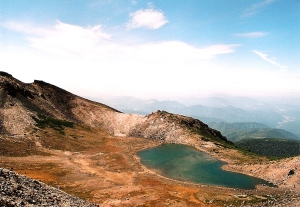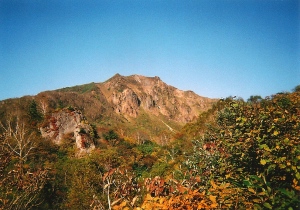The most direct route from Matsumoto to Osaka is not up and over a 3000m high volcano. Regardless, I somehow convinced myself that climbing Mt. Norikura is indeed on my home and I’d be foolish enough not to drop by and say hello. This justification had nothing whatsoever to do with the previous day’s soggy ascent of Mt. Yake. Nor did it have any connection to the picture perfect weather that presented itself on a wonderful autumn in early October.

I checked out of the hotel early and boarded the train to Shin-shimashima, where a bus was waiting to whisk me to Norikura-kogen. From there, I queued up for the long, windy shuttle bus to Tatami-daira, the site of a recent bear attack. The overdeveloped plateau, situated at 2700m above sea level, cuts a good 1000 vertical meters off of what used to be a challenging climb. The massive parking lot is a testament to the extraordinary crowds that swarm the peak during the summer months, but on this calm, cool Monday morning there was hardly a soul in sight.

I flew up towards the summit of Mt, Fujimi, only to be slowed by an endless array of wooden steps built into the exposed hillside. “Perhaps I should’ve done a few laps around the parking lot before setting off,” I admitted, realizing I was an early victim to the thin air. Panting like a out-of-shape St. Bernard on a hot, muggy day, I tiptoed up to the top of the peak, where, on a clear day, the conical shape of Mt. Fuji stands out on the horizon. Clarity wasn’t a problem on this particular morning. Even though I could see every other peak within a 200km radius, Mt. Fuji and the peaks of the Minami Alps were playing a game of hide-and-seek among the convective clouds.

Mt. Norikura, like its more sacred neighbor Ontake to the south, is a volcanic plateau darted with
scenic volcanic lakes. In fact, most of the visitors stay on the asphalt trails well below the semicircular peaks above. I had Mt. Fujimi completely to myself, but ran into a few groups as the trail met up with the concrete again. I didn’t mind, though, as the outstanding weather more than made up for the unwelcome companionship.

Scooting along on a concrete path, past a large, well-equipped mountain hut, I finally caught a glimpse of the summit of Ken-ga-mine, the high point of Mt. Norikura. With my body finally acclimatized, I flew past crowds out crawling pensioners until reaching the large shrine on the peak. Panoramic views in all directions more than made up for the misty drudgery of the day before. Mt. Yake stuck its steaming tongue out as if to tease me for climbing in such bombastic conditions. “Revenge will be mine”, I vowed.

After the necessary summit proofs, I retraced my steps back to the parking lot and caught a bus towards Takayama and then a train back to Osaka. Mt. Norikura definitely thanked me for dropping by on the way home, and wished me luck on my upcoming attempt of Mt. Arashima, mountain #39.






























